Singapore's Economy: Analyzing Production, Labor, and Price Trends
VerifiedAdded on 2023/06/15
|11
|2815
|338
Report
AI Summary
This report provides an analysis of Singapore's economic performance, focusing on production output, labor market dynamics, and price levels over the past decade. It highlights Singapore's impressive GDP growth, driven by strategic policies and foreign labor influx, despite challenges like declining birth rates. The labor market analysis reveals a decline in unemployment rates, but also structural unemployment issues due to the shift from labor-intensive to capital-intensive industries. Government investments in education and training aim to address these challenges. The report also examines Singapore's inflation rate, noting its fluctuations and the government's efforts to manage prices through fiscal and monetary policies. Overall, the analysis underscores Singapore's resilience and adaptability in maintaining a strong economic position amidst global economic shifts.
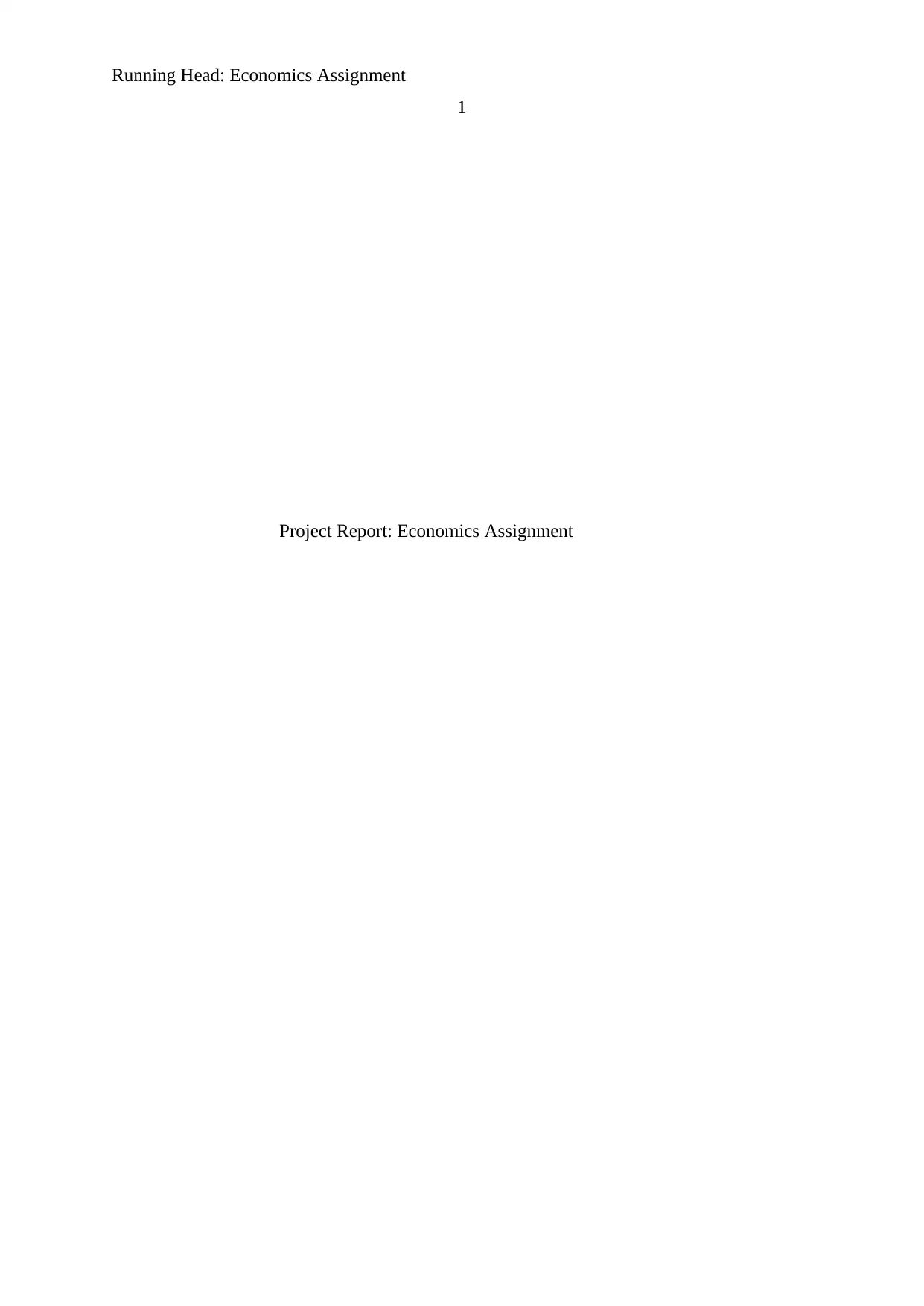
Running Head: Economics Assignment
1
Project Report: Economics Assignment
1
Project Report: Economics Assignment
Paraphrase This Document
Need a fresh take? Get an instant paraphrase of this document with our AI Paraphraser
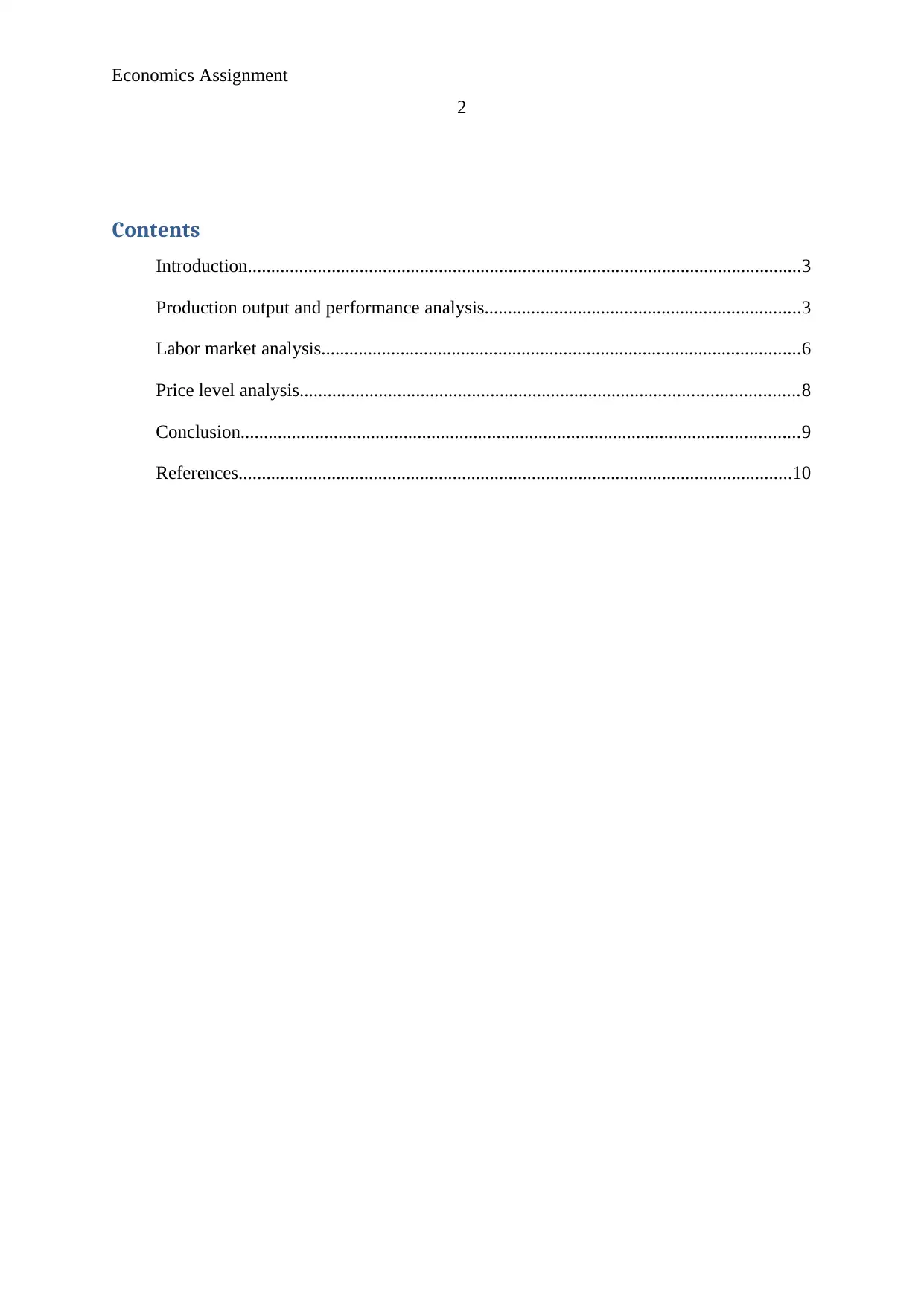
Economics Assignment
2
Contents
Introduction.......................................................................................................................3
Production output and performance analysis....................................................................3
Labor market analysis.......................................................................................................6
Price level analysis...........................................................................................................8
Conclusion........................................................................................................................9
References.......................................................................................................................10
2
Contents
Introduction.......................................................................................................................3
Production output and performance analysis....................................................................3
Labor market analysis.......................................................................................................6
Price level analysis...........................................................................................................8
Conclusion........................................................................................................................9
References.......................................................................................................................10
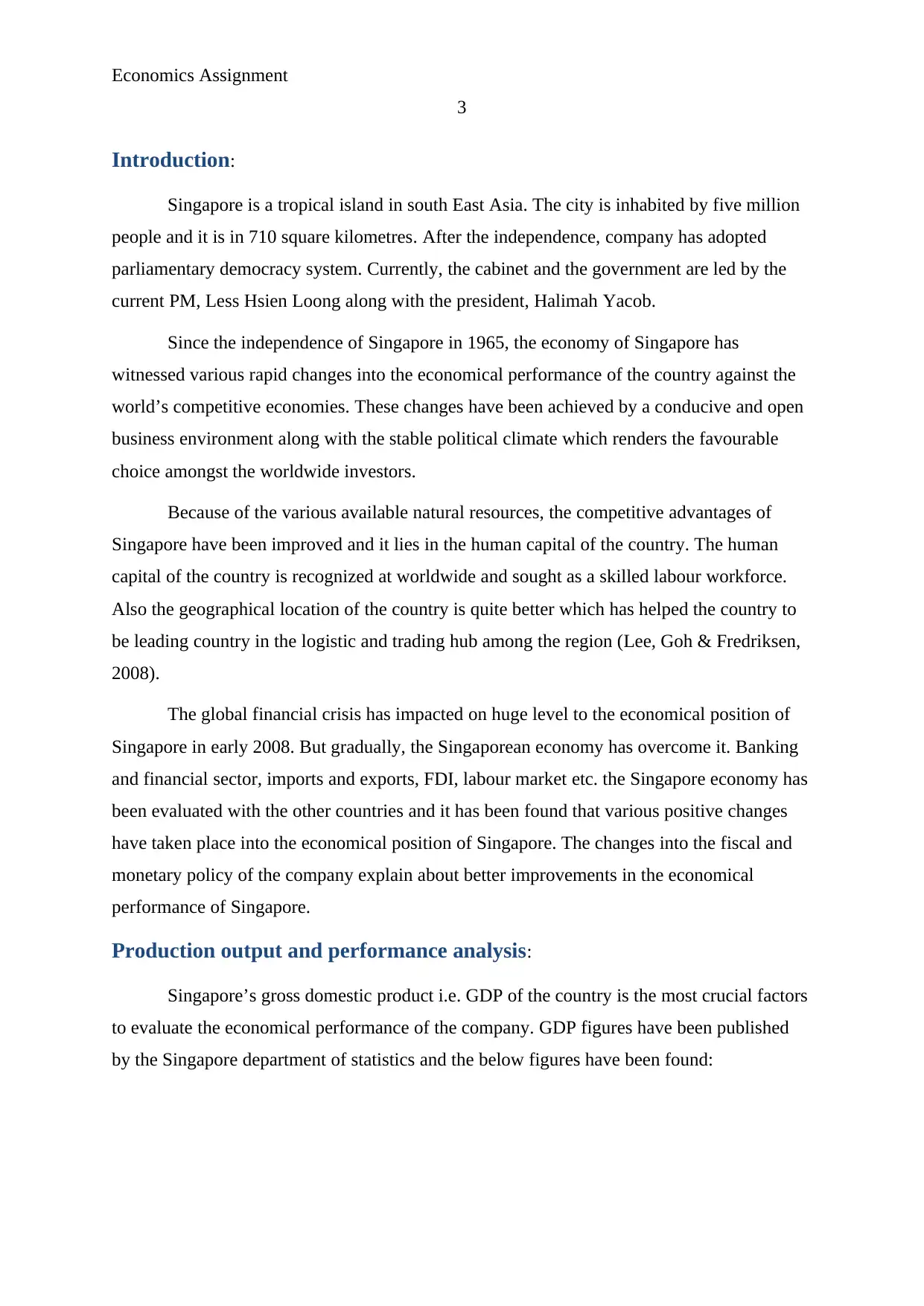
Economics Assignment
3
Introduction:
Singapore is a tropical island in south East Asia. The city is inhabited by five million
people and it is in 710 square kilometres. After the independence, company has adopted
parliamentary democracy system. Currently, the cabinet and the government are led by the
current PM, Less Hsien Loong along with the president, Halimah Yacob.
Since the independence of Singapore in 1965, the economy of Singapore has
witnessed various rapid changes into the economical performance of the country against the
world’s competitive economies. These changes have been achieved by a conducive and open
business environment along with the stable political climate which renders the favourable
choice amongst the worldwide investors.
Because of the various available natural resources, the competitive advantages of
Singapore have been improved and it lies in the human capital of the country. The human
capital of the country is recognized at worldwide and sought as a skilled labour workforce.
Also the geographical location of the country is quite better which has helped the country to
be leading country in the logistic and trading hub among the region (Lee, Goh & Fredriksen,
2008).
The global financial crisis has impacted on huge level to the economical position of
Singapore in early 2008. But gradually, the Singaporean economy has overcome it. Banking
and financial sector, imports and exports, FDI, labour market etc. the Singapore economy has
been evaluated with the other countries and it has been found that various positive changes
have taken place into the economical position of Singapore. The changes into the fiscal and
monetary policy of the company explain about better improvements in the economical
performance of Singapore.
Production output and performance analysis:
Singapore’s gross domestic product i.e. GDP of the country is the most crucial factors
to evaluate the economical performance of the company. GDP figures have been published
by the Singapore department of statistics and the below figures have been found:
3
Introduction:
Singapore is a tropical island in south East Asia. The city is inhabited by five million
people and it is in 710 square kilometres. After the independence, company has adopted
parliamentary democracy system. Currently, the cabinet and the government are led by the
current PM, Less Hsien Loong along with the president, Halimah Yacob.
Since the independence of Singapore in 1965, the economy of Singapore has
witnessed various rapid changes into the economical performance of the country against the
world’s competitive economies. These changes have been achieved by a conducive and open
business environment along with the stable political climate which renders the favourable
choice amongst the worldwide investors.
Because of the various available natural resources, the competitive advantages of
Singapore have been improved and it lies in the human capital of the country. The human
capital of the country is recognized at worldwide and sought as a skilled labour workforce.
Also the geographical location of the country is quite better which has helped the country to
be leading country in the logistic and trading hub among the region (Lee, Goh & Fredriksen,
2008).
The global financial crisis has impacted on huge level to the economical position of
Singapore in early 2008. But gradually, the Singaporean economy has overcome it. Banking
and financial sector, imports and exports, FDI, labour market etc. the Singapore economy has
been evaluated with the other countries and it has been found that various positive changes
have taken place into the economical position of Singapore. The changes into the fiscal and
monetary policy of the company explain about better improvements in the economical
performance of Singapore.
Production output and performance analysis:
Singapore’s gross domestic product i.e. GDP of the country is the most crucial factors
to evaluate the economical performance of the company. GDP figures have been published
by the Singapore department of statistics and the below figures have been found:
⊘ This is a preview!⊘
Do you want full access?
Subscribe today to unlock all pages.

Trusted by 1+ million students worldwide
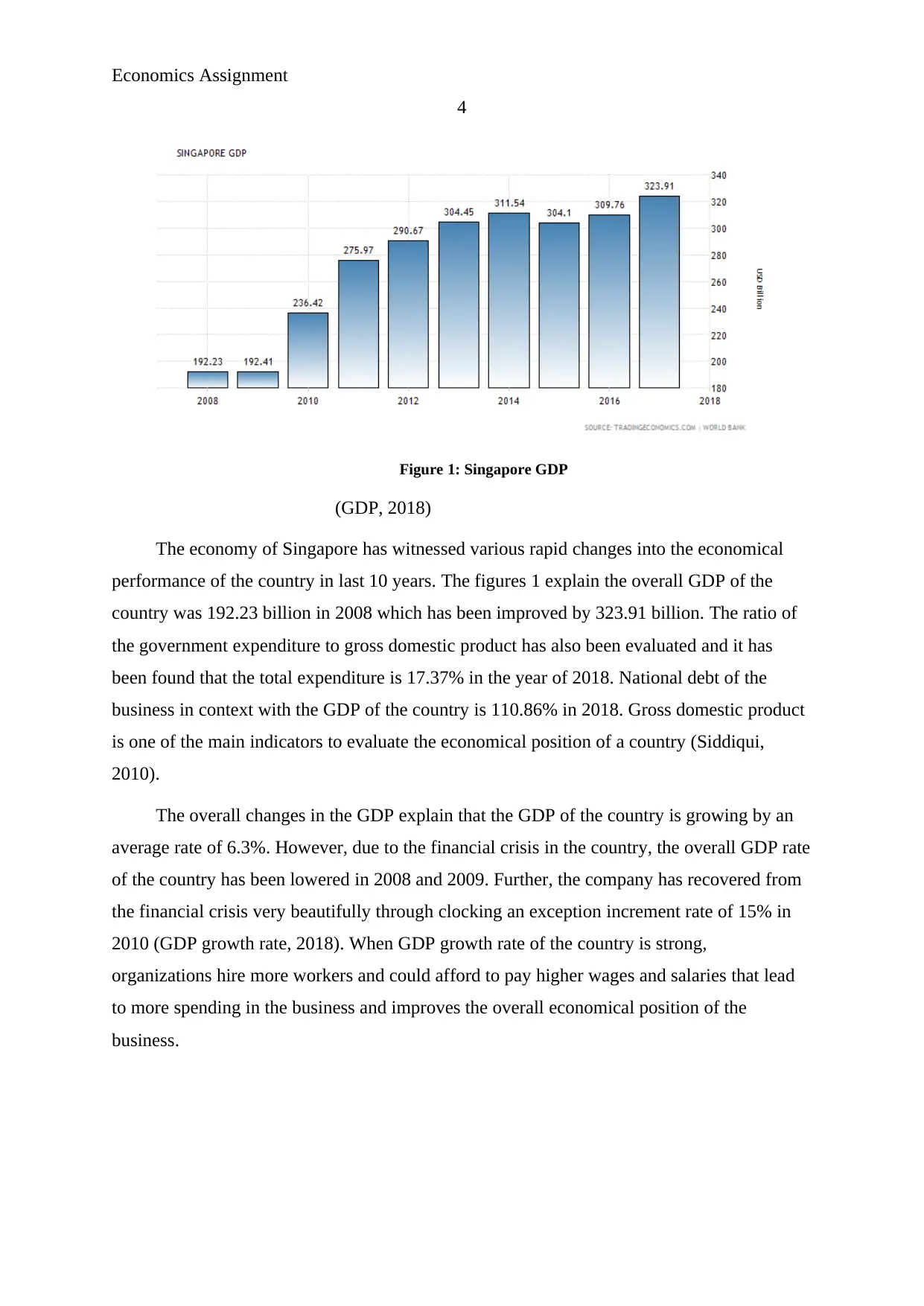
Economics Assignment
4
Figure 1: Singapore GDP
(GDP, 2018)
The economy of Singapore has witnessed various rapid changes into the economical
performance of the country in last 10 years. The figures 1 explain the overall GDP of the
country was 192.23 billion in 2008 which has been improved by 323.91 billion. The ratio of
the government expenditure to gross domestic product has also been evaluated and it has
been found that the total expenditure is 17.37% in the year of 2018. National debt of the
business in context with the GDP of the country is 110.86% in 2018. Gross domestic product
is one of the main indicators to evaluate the economical position of a country (Siddiqui,
2010).
The overall changes in the GDP explain that the GDP of the country is growing by an
average rate of 6.3%. However, due to the financial crisis in the country, the overall GDP rate
of the country has been lowered in 2008 and 2009. Further, the company has recovered from
the financial crisis very beautifully through clocking an exception increment rate of 15% in
2010 (GDP growth rate, 2018). When GDP growth rate of the country is strong,
organizations hire more workers and could afford to pay higher wages and salaries that lead
to more spending in the business and improves the overall economical position of the
business.
4
Figure 1: Singapore GDP
(GDP, 2018)
The economy of Singapore has witnessed various rapid changes into the economical
performance of the country in last 10 years. The figures 1 explain the overall GDP of the
country was 192.23 billion in 2008 which has been improved by 323.91 billion. The ratio of
the government expenditure to gross domestic product has also been evaluated and it has
been found that the total expenditure is 17.37% in the year of 2018. National debt of the
business in context with the GDP of the country is 110.86% in 2018. Gross domestic product
is one of the main indicators to evaluate the economical position of a country (Siddiqui,
2010).
The overall changes in the GDP explain that the GDP of the country is growing by an
average rate of 6.3%. However, due to the financial crisis in the country, the overall GDP rate
of the country has been lowered in 2008 and 2009. Further, the company has recovered from
the financial crisis very beautifully through clocking an exception increment rate of 15% in
2010 (GDP growth rate, 2018). When GDP growth rate of the country is strong,
organizations hire more workers and could afford to pay higher wages and salaries that lead
to more spending in the business and improves the overall economical position of the
business.
Paraphrase This Document
Need a fresh take? Get an instant paraphrase of this document with our AI Paraphraser
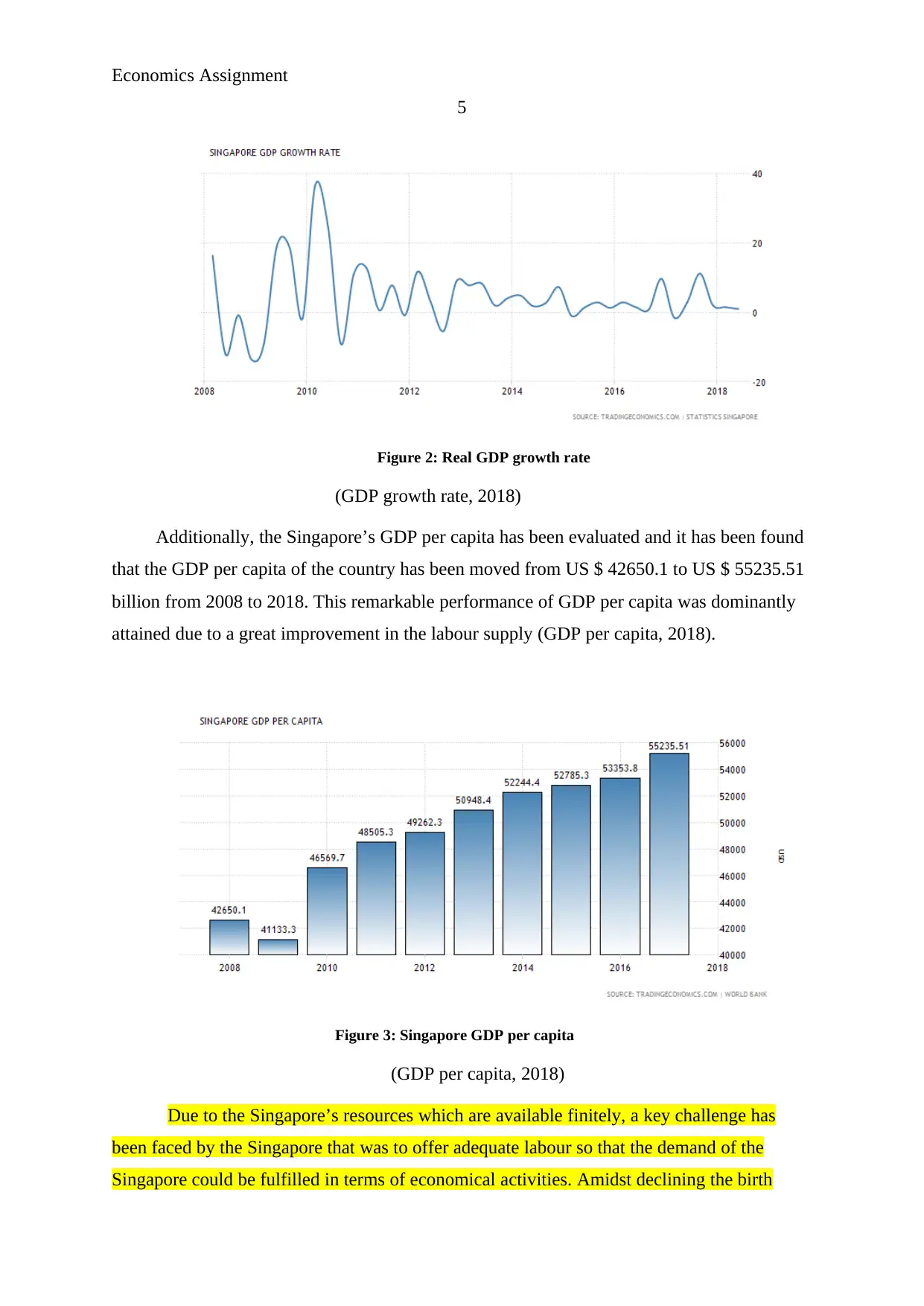
Economics Assignment
5
Figure 2: Real GDP growth rate
(GDP growth rate, 2018)
Additionally, the Singapore’s GDP per capita has been evaluated and it has been found
that the GDP per capita of the country has been moved from US $ 42650.1 to US $ 55235.51
billion from 2008 to 2018. This remarkable performance of GDP per capita was dominantly
attained due to a great improvement in the labour supply (GDP per capita, 2018).
Figure 3: Singapore GDP per capita
(GDP per capita, 2018)
Due to the Singapore’s resources which are available finitely, a key challenge has
been faced by the Singapore that was to offer adequate labour so that the demand of the
Singapore could be fulfilled in terms of economical activities. Amidst declining the birth
5
Figure 2: Real GDP growth rate
(GDP growth rate, 2018)
Additionally, the Singapore’s GDP per capita has been evaluated and it has been found
that the GDP per capita of the country has been moved from US $ 42650.1 to US $ 55235.51
billion from 2008 to 2018. This remarkable performance of GDP per capita was dominantly
attained due to a great improvement in the labour supply (GDP per capita, 2018).
Figure 3: Singapore GDP per capita
(GDP per capita, 2018)
Due to the Singapore’s resources which are available finitely, a key challenge has
been faced by the Singapore that was to offer adequate labour so that the demand of the
Singapore could be fulfilled in terms of economical activities. Amidst declining the birth
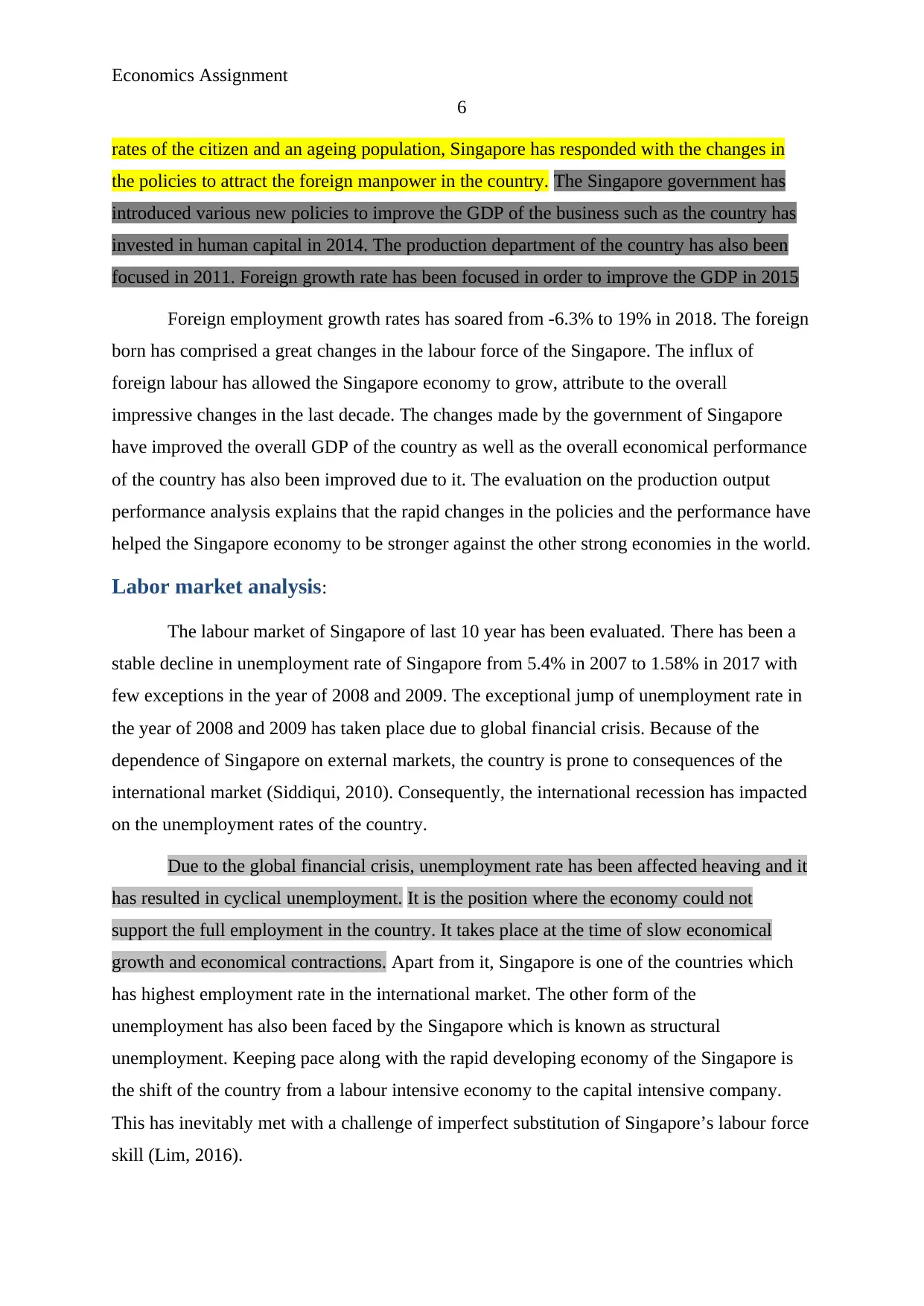
Economics Assignment
6
rates of the citizen and an ageing population, Singapore has responded with the changes in
the policies to attract the foreign manpower in the country. The Singapore government has
introduced various new policies to improve the GDP of the business such as the country has
invested in human capital in 2014. The production department of the country has also been
focused in 2011. Foreign growth rate has been focused in order to improve the GDP in 2015
Foreign employment growth rates has soared from -6.3% to 19% in 2018. The foreign
born has comprised a great changes in the labour force of the Singapore. The influx of
foreign labour has allowed the Singapore economy to grow, attribute to the overall
impressive changes in the last decade. The changes made by the government of Singapore
have improved the overall GDP of the country as well as the overall economical performance
of the country has also been improved due to it. The evaluation on the production output
performance analysis explains that the rapid changes in the policies and the performance have
helped the Singapore economy to be stronger against the other strong economies in the world.
Labor market analysis:
The labour market of Singapore of last 10 year has been evaluated. There has been a
stable decline in unemployment rate of Singapore from 5.4% in 2007 to 1.58% in 2017 with
few exceptions in the year of 2008 and 2009. The exceptional jump of unemployment rate in
the year of 2008 and 2009 has taken place due to global financial crisis. Because of the
dependence of Singapore on external markets, the country is prone to consequences of the
international market (Siddiqui, 2010). Consequently, the international recession has impacted
on the unemployment rates of the country.
Due to the global financial crisis, unemployment rate has been affected heaving and it
has resulted in cyclical unemployment. It is the position where the economy could not
support the full employment in the country. It takes place at the time of slow economical
growth and economical contractions. Apart from it, Singapore is one of the countries which
has highest employment rate in the international market. The other form of the
unemployment has also been faced by the Singapore which is known as structural
unemployment. Keeping pace along with the rapid developing economy of the Singapore is
the shift of the country from a labour intensive economy to the capital intensive company.
This has inevitably met with a challenge of imperfect substitution of Singapore’s labour force
skill (Lim, 2016).
6
rates of the citizen and an ageing population, Singapore has responded with the changes in
the policies to attract the foreign manpower in the country. The Singapore government has
introduced various new policies to improve the GDP of the business such as the country has
invested in human capital in 2014. The production department of the country has also been
focused in 2011. Foreign growth rate has been focused in order to improve the GDP in 2015
Foreign employment growth rates has soared from -6.3% to 19% in 2018. The foreign
born has comprised a great changes in the labour force of the Singapore. The influx of
foreign labour has allowed the Singapore economy to grow, attribute to the overall
impressive changes in the last decade. The changes made by the government of Singapore
have improved the overall GDP of the country as well as the overall economical performance
of the country has also been improved due to it. The evaluation on the production output
performance analysis explains that the rapid changes in the policies and the performance have
helped the Singapore economy to be stronger against the other strong economies in the world.
Labor market analysis:
The labour market of Singapore of last 10 year has been evaluated. There has been a
stable decline in unemployment rate of Singapore from 5.4% in 2007 to 1.58% in 2017 with
few exceptions in the year of 2008 and 2009. The exceptional jump of unemployment rate in
the year of 2008 and 2009 has taken place due to global financial crisis. Because of the
dependence of Singapore on external markets, the country is prone to consequences of the
international market (Siddiqui, 2010). Consequently, the international recession has impacted
on the unemployment rates of the country.
Due to the global financial crisis, unemployment rate has been affected heaving and it
has resulted in cyclical unemployment. It is the position where the economy could not
support the full employment in the country. It takes place at the time of slow economical
growth and economical contractions. Apart from it, Singapore is one of the countries which
has highest employment rate in the international market. The other form of the
unemployment has also been faced by the Singapore which is known as structural
unemployment. Keeping pace along with the rapid developing economy of the Singapore is
the shift of the country from a labour intensive economy to the capital intensive company.
This has inevitably met with a challenge of imperfect substitution of Singapore’s labour force
skill (Lim, 2016).
⊘ This is a preview!⊘
Do you want full access?
Subscribe today to unlock all pages.

Trusted by 1+ million students worldwide
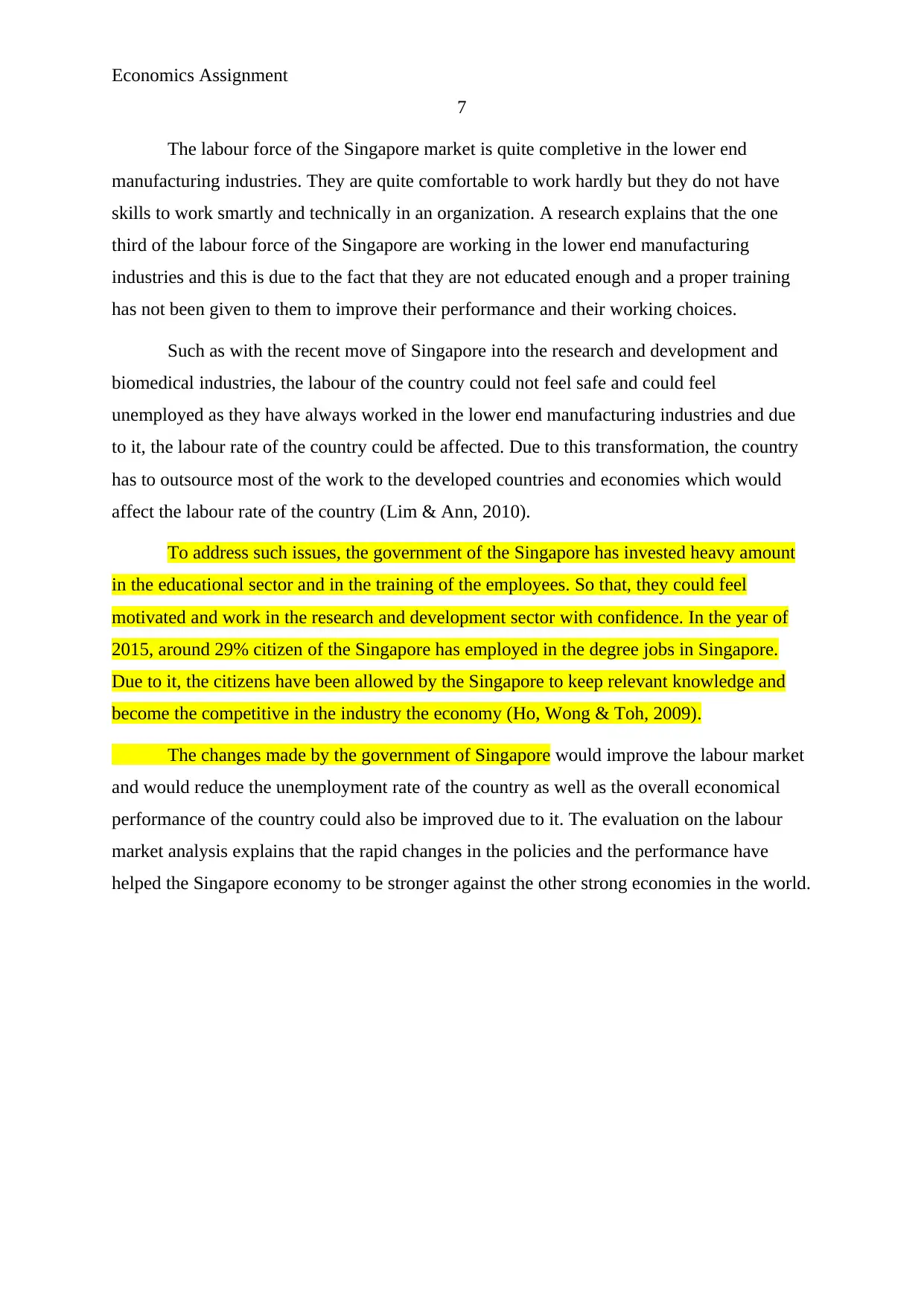
Economics Assignment
7
The labour force of the Singapore market is quite completive in the lower end
manufacturing industries. They are quite comfortable to work hardly but they do not have
skills to work smartly and technically in an organization. A research explains that the one
third of the labour force of the Singapore are working in the lower end manufacturing
industries and this is due to the fact that they are not educated enough and a proper training
has not been given to them to improve their performance and their working choices.
Such as with the recent move of Singapore into the research and development and
biomedical industries, the labour of the country could not feel safe and could feel
unemployed as they have always worked in the lower end manufacturing industries and due
to it, the labour rate of the country could be affected. Due to this transformation, the country
has to outsource most of the work to the developed countries and economies which would
affect the labour rate of the country (Lim & Ann, 2010).
To address such issues, the government of the Singapore has invested heavy amount
in the educational sector and in the training of the employees. So that, they could feel
motivated and work in the research and development sector with confidence. In the year of
2015, around 29% citizen of the Singapore has employed in the degree jobs in Singapore.
Due to it, the citizens have been allowed by the Singapore to keep relevant knowledge and
become the competitive in the industry the economy (Ho, Wong & Toh, 2009).
The changes made by the government of Singapore would improve the labour market
and would reduce the unemployment rate of the country as well as the overall economical
performance of the country could also be improved due to it. The evaluation on the labour
market analysis explains that the rapid changes in the policies and the performance have
helped the Singapore economy to be stronger against the other strong economies in the world.
7
The labour force of the Singapore market is quite completive in the lower end
manufacturing industries. They are quite comfortable to work hardly but they do not have
skills to work smartly and technically in an organization. A research explains that the one
third of the labour force of the Singapore are working in the lower end manufacturing
industries and this is due to the fact that they are not educated enough and a proper training
has not been given to them to improve their performance and their working choices.
Such as with the recent move of Singapore into the research and development and
biomedical industries, the labour of the country could not feel safe and could feel
unemployed as they have always worked in the lower end manufacturing industries and due
to it, the labour rate of the country could be affected. Due to this transformation, the country
has to outsource most of the work to the developed countries and economies which would
affect the labour rate of the country (Lim & Ann, 2010).
To address such issues, the government of the Singapore has invested heavy amount
in the educational sector and in the training of the employees. So that, they could feel
motivated and work in the research and development sector with confidence. In the year of
2015, around 29% citizen of the Singapore has employed in the degree jobs in Singapore.
Due to it, the citizens have been allowed by the Singapore to keep relevant knowledge and
become the competitive in the industry the economy (Ho, Wong & Toh, 2009).
The changes made by the government of Singapore would improve the labour market
and would reduce the unemployment rate of the country as well as the overall economical
performance of the country could also be improved due to it. The evaluation on the labour
market analysis explains that the rapid changes in the policies and the performance have
helped the Singapore economy to be stronger against the other strong economies in the world.
Paraphrase This Document
Need a fresh take? Get an instant paraphrase of this document with our AI Paraphraser
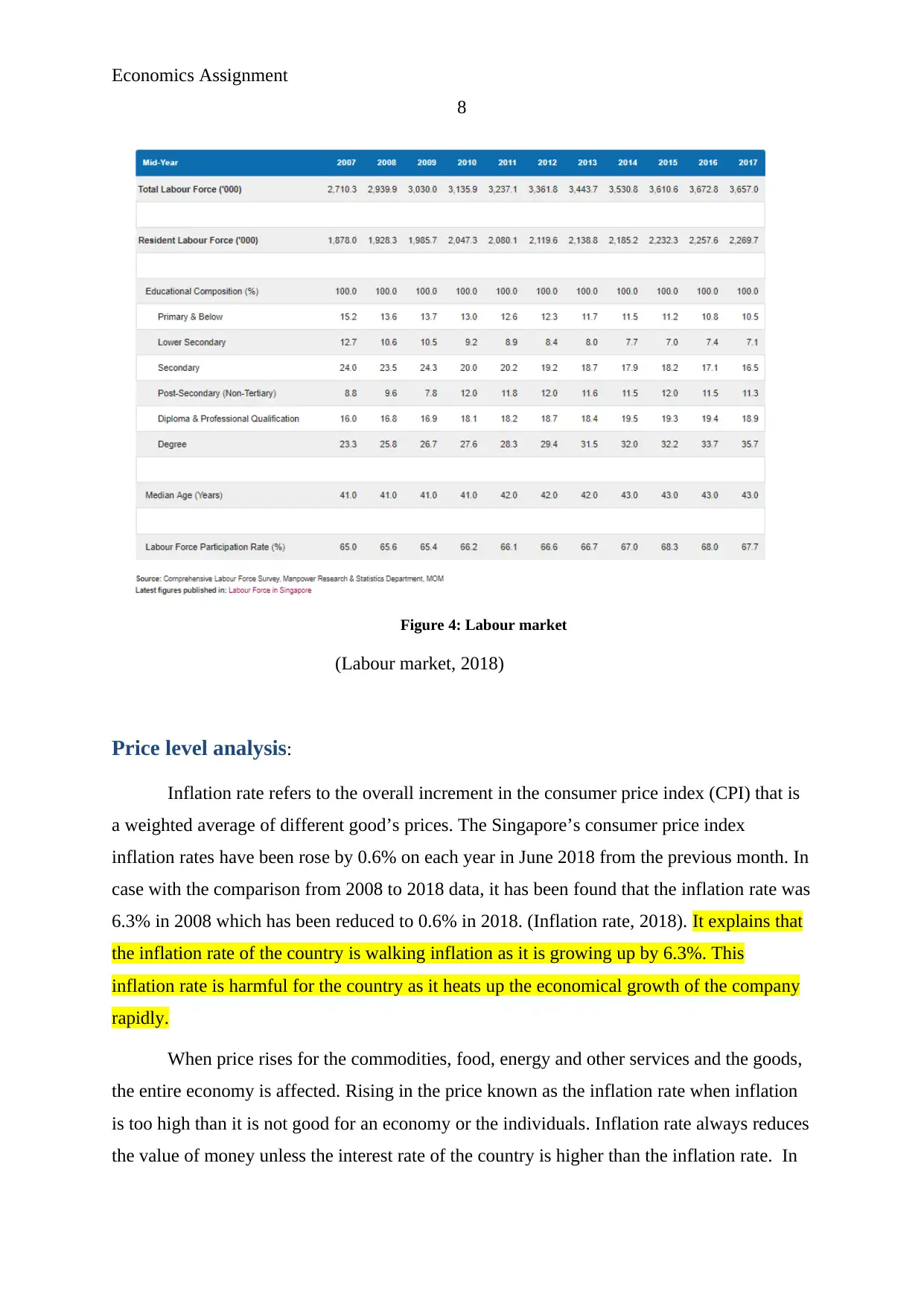
Economics Assignment
8
Figure 4: Labour market
(Labour market, 2018)
Price level analysis:
Inflation rate refers to the overall increment in the consumer price index (CPI) that is
a weighted average of different good’s prices. The Singapore’s consumer price index
inflation rates have been rose by 0.6% on each year in June 2018 from the previous month. In
case with the comparison from 2008 to 2018 data, it has been found that the inflation rate was
6.3% in 2008 which has been reduced to 0.6% in 2018. (Inflation rate, 2018). It explains that
the inflation rate of the country is walking inflation as it is growing up by 6.3%. This
inflation rate is harmful for the country as it heats up the economical growth of the company
rapidly.
When price rises for the commodities, food, energy and other services and the goods,
the entire economy is affected. Rising in the price known as the inflation rate when inflation
is too high than it is not good for an economy or the individuals. Inflation rate always reduces
the value of money unless the interest rate of the country is higher than the inflation rate. In
8
Figure 4: Labour market
(Labour market, 2018)
Price level analysis:
Inflation rate refers to the overall increment in the consumer price index (CPI) that is
a weighted average of different good’s prices. The Singapore’s consumer price index
inflation rates have been rose by 0.6% on each year in June 2018 from the previous month. In
case with the comparison from 2008 to 2018 data, it has been found that the inflation rate was
6.3% in 2008 which has been reduced to 0.6% in 2018. (Inflation rate, 2018). It explains that
the inflation rate of the country is walking inflation as it is growing up by 6.3%. This
inflation rate is harmful for the country as it heats up the economical growth of the company
rapidly.
When price rises for the commodities, food, energy and other services and the goods,
the entire economy is affected. Rising in the price known as the inflation rate when inflation
is too high than it is not good for an economy or the individuals. Inflation rate always reduces
the value of money unless the interest rate of the country is higher than the inflation rate. In
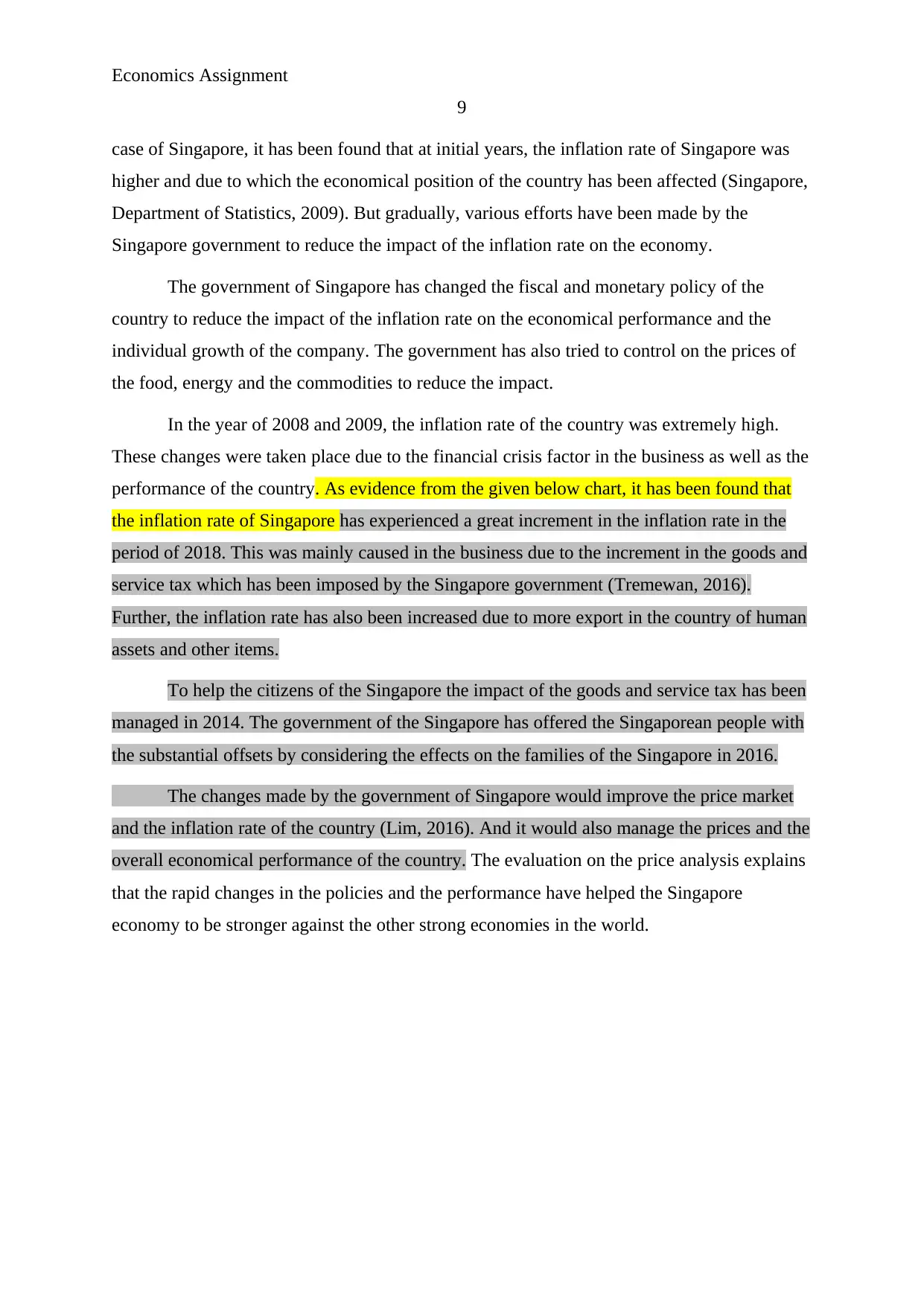
Economics Assignment
9
case of Singapore, it has been found that at initial years, the inflation rate of Singapore was
higher and due to which the economical position of the country has been affected (Singapore,
Department of Statistics, 2009). But gradually, various efforts have been made by the
Singapore government to reduce the impact of the inflation rate on the economy.
The government of Singapore has changed the fiscal and monetary policy of the
country to reduce the impact of the inflation rate on the economical performance and the
individual growth of the company. The government has also tried to control on the prices of
the food, energy and the commodities to reduce the impact.
In the year of 2008 and 2009, the inflation rate of the country was extremely high.
These changes were taken place due to the financial crisis factor in the business as well as the
performance of the country. As evidence from the given below chart, it has been found that
the inflation rate of Singapore has experienced a great increment in the inflation rate in the
period of 2018. This was mainly caused in the business due to the increment in the goods and
service tax which has been imposed by the Singapore government (Tremewan, 2016).
Further, the inflation rate has also been increased due to more export in the country of human
assets and other items.
To help the citizens of the Singapore the impact of the goods and service tax has been
managed in 2014. The government of the Singapore has offered the Singaporean people with
the substantial offsets by considering the effects on the families of the Singapore in 2016.
The changes made by the government of Singapore would improve the price market
and the inflation rate of the country (Lim, 2016). And it would also manage the prices and the
overall economical performance of the country. The evaluation on the price analysis explains
that the rapid changes in the policies and the performance have helped the Singapore
economy to be stronger against the other strong economies in the world.
9
case of Singapore, it has been found that at initial years, the inflation rate of Singapore was
higher and due to which the economical position of the country has been affected (Singapore,
Department of Statistics, 2009). But gradually, various efforts have been made by the
Singapore government to reduce the impact of the inflation rate on the economy.
The government of Singapore has changed the fiscal and monetary policy of the
country to reduce the impact of the inflation rate on the economical performance and the
individual growth of the company. The government has also tried to control on the prices of
the food, energy and the commodities to reduce the impact.
In the year of 2008 and 2009, the inflation rate of the country was extremely high.
These changes were taken place due to the financial crisis factor in the business as well as the
performance of the country. As evidence from the given below chart, it has been found that
the inflation rate of Singapore has experienced a great increment in the inflation rate in the
period of 2018. This was mainly caused in the business due to the increment in the goods and
service tax which has been imposed by the Singapore government (Tremewan, 2016).
Further, the inflation rate has also been increased due to more export in the country of human
assets and other items.
To help the citizens of the Singapore the impact of the goods and service tax has been
managed in 2014. The government of the Singapore has offered the Singaporean people with
the substantial offsets by considering the effects on the families of the Singapore in 2016.
The changes made by the government of Singapore would improve the price market
and the inflation rate of the country (Lim, 2016). And it would also manage the prices and the
overall economical performance of the country. The evaluation on the price analysis explains
that the rapid changes in the policies and the performance have helped the Singapore
economy to be stronger against the other strong economies in the world.
⊘ This is a preview!⊘
Do you want full access?
Subscribe today to unlock all pages.

Trusted by 1+ million students worldwide
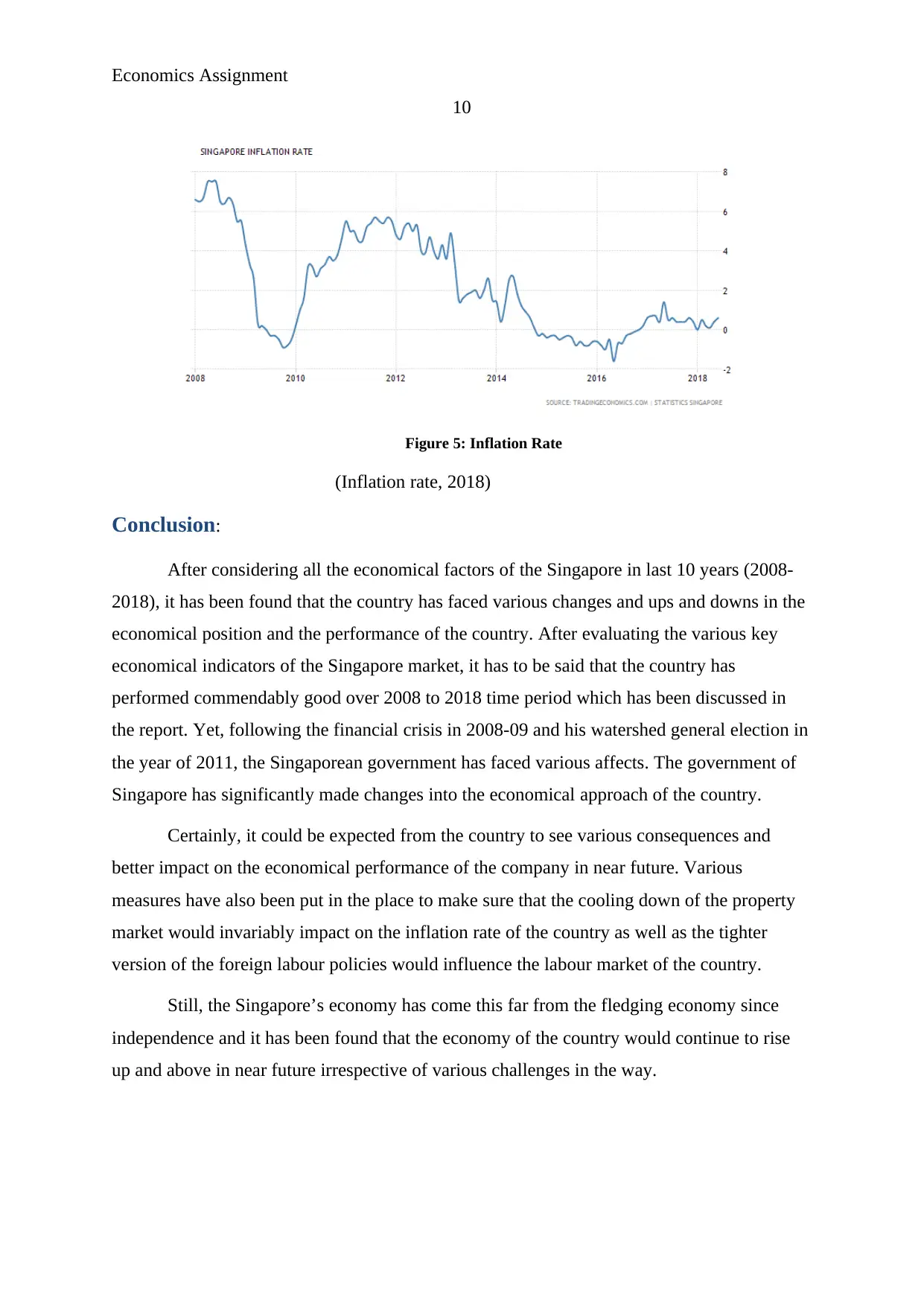
Economics Assignment
10
Figure 5: Inflation Rate
(Inflation rate, 2018)
Conclusion:
After considering all the economical factors of the Singapore in last 10 years (2008-
2018), it has been found that the country has faced various changes and ups and downs in the
economical position and the performance of the country. After evaluating the various key
economical indicators of the Singapore market, it has to be said that the country has
performed commendably good over 2008 to 2018 time period which has been discussed in
the report. Yet, following the financial crisis in 2008-09 and his watershed general election in
the year of 2011, the Singaporean government has faced various affects. The government of
Singapore has significantly made changes into the economical approach of the country.
Certainly, it could be expected from the country to see various consequences and
better impact on the economical performance of the company in near future. Various
measures have also been put in the place to make sure that the cooling down of the property
market would invariably impact on the inflation rate of the country as well as the tighter
version of the foreign labour policies would influence the labour market of the country.
Still, the Singapore’s economy has come this far from the fledging economy since
independence and it has been found that the economy of the country would continue to rise
up and above in near future irrespective of various challenges in the way.
10
Figure 5: Inflation Rate
(Inflation rate, 2018)
Conclusion:
After considering all the economical factors of the Singapore in last 10 years (2008-
2018), it has been found that the country has faced various changes and ups and downs in the
economical position and the performance of the country. After evaluating the various key
economical indicators of the Singapore market, it has to be said that the country has
performed commendably good over 2008 to 2018 time period which has been discussed in
the report. Yet, following the financial crisis in 2008-09 and his watershed general election in
the year of 2011, the Singaporean government has faced various affects. The government of
Singapore has significantly made changes into the economical approach of the country.
Certainly, it could be expected from the country to see various consequences and
better impact on the economical performance of the company in near future. Various
measures have also been put in the place to make sure that the cooling down of the property
market would invariably impact on the inflation rate of the country as well as the tighter
version of the foreign labour policies would influence the labour market of the country.
Still, the Singapore’s economy has come this far from the fledging economy since
independence and it has been found that the economy of the country would continue to rise
up and above in near future irrespective of various challenges in the way.
Paraphrase This Document
Need a fresh take? Get an instant paraphrase of this document with our AI Paraphraser
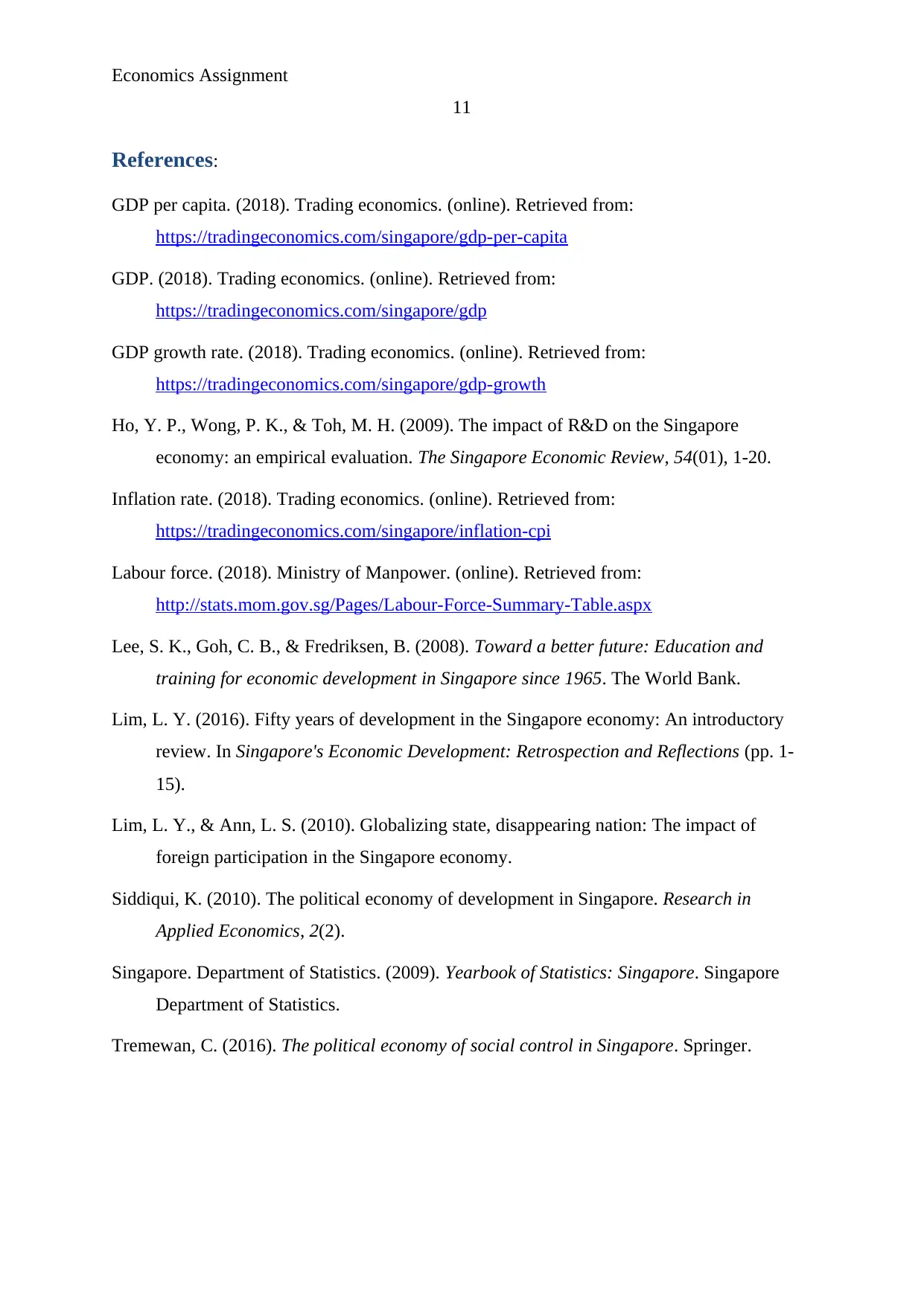
Economics Assignment
11
References:
GDP per capita. (2018). Trading economics. (online). Retrieved from:
https://tradingeconomics.com/singapore/gdp-per-capita
GDP. (2018). Trading economics. (online). Retrieved from:
https://tradingeconomics.com/singapore/gdp
GDP growth rate. (2018). Trading economics. (online). Retrieved from:
https://tradingeconomics.com/singapore/gdp-growth
Ho, Y. P., Wong, P. K., & Toh, M. H. (2009). The impact of R&D on the Singapore
economy: an empirical evaluation. The Singapore Economic Review, 54(01), 1-20.
Inflation rate. (2018). Trading economics. (online). Retrieved from:
https://tradingeconomics.com/singapore/inflation-cpi
Labour force. (2018). Ministry of Manpower. (online). Retrieved from:
http://stats.mom.gov.sg/Pages/Labour-Force-Summary-Table.aspx
Lee, S. K., Goh, C. B., & Fredriksen, B. (2008). Toward a better future: Education and
training for economic development in Singapore since 1965. The World Bank.
Lim, L. Y. (2016). Fifty years of development in the Singapore economy: An introductory
review. In Singapore's Economic Development: Retrospection and Reflections (pp. 1-
15).
Lim, L. Y., & Ann, L. S. (2010). Globalizing state, disappearing nation: The impact of
foreign participation in the Singapore economy.
Siddiqui, K. (2010). The political economy of development in Singapore. Research in
Applied Economics, 2(2).
Singapore. Department of Statistics. (2009). Yearbook of Statistics: Singapore. Singapore
Department of Statistics.
Tremewan, C. (2016). The political economy of social control in Singapore. Springer.
11
References:
GDP per capita. (2018). Trading economics. (online). Retrieved from:
https://tradingeconomics.com/singapore/gdp-per-capita
GDP. (2018). Trading economics. (online). Retrieved from:
https://tradingeconomics.com/singapore/gdp
GDP growth rate. (2018). Trading economics. (online). Retrieved from:
https://tradingeconomics.com/singapore/gdp-growth
Ho, Y. P., Wong, P. K., & Toh, M. H. (2009). The impact of R&D on the Singapore
economy: an empirical evaluation. The Singapore Economic Review, 54(01), 1-20.
Inflation rate. (2018). Trading economics. (online). Retrieved from:
https://tradingeconomics.com/singapore/inflation-cpi
Labour force. (2018). Ministry of Manpower. (online). Retrieved from:
http://stats.mom.gov.sg/Pages/Labour-Force-Summary-Table.aspx
Lee, S. K., Goh, C. B., & Fredriksen, B. (2008). Toward a better future: Education and
training for economic development in Singapore since 1965. The World Bank.
Lim, L. Y. (2016). Fifty years of development in the Singapore economy: An introductory
review. In Singapore's Economic Development: Retrospection and Reflections (pp. 1-
15).
Lim, L. Y., & Ann, L. S. (2010). Globalizing state, disappearing nation: The impact of
foreign participation in the Singapore economy.
Siddiqui, K. (2010). The political economy of development in Singapore. Research in
Applied Economics, 2(2).
Singapore. Department of Statistics. (2009). Yearbook of Statistics: Singapore. Singapore
Department of Statistics.
Tremewan, C. (2016). The political economy of social control in Singapore. Springer.
1 out of 11
Related Documents
Your All-in-One AI-Powered Toolkit for Academic Success.
+13062052269
info@desklib.com
Available 24*7 on WhatsApp / Email
![[object Object]](/_next/static/media/star-bottom.7253800d.svg)
Unlock your academic potential
Copyright © 2020–2025 A2Z Services. All Rights Reserved. Developed and managed by ZUCOL.




